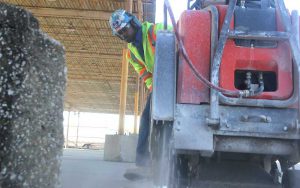
Concrete dust and debris are a real problem in the concrete coring and cutting industry. That’s one of the reasons water is used in the concrete coring and cutting process. Let’s discuss this idea further and examine other reasons water is used to cut and core concrete and other hard surfaces.
Water is used in the concrete coring and cutting process for health and safety reasons.
Breathing in crystalline silica can cause irreversible damage to the lungs. Concrete dust and debris can also enter the technician’s eyes, causing severe eye damage or irritation. And the dust and debris are not only bad for the operator. It’s also harmful to everyone at the work site who may not be wearing protective safety gear.
In short, wet concrete cutting must be done in enclosed areas to reduce the amount of harmful dust particles entering the air. Again, dry-cutting concrete in an enclosed space can cause suffocation from the dust, long-term lung damage, and other fatal effects.
Water keeps the concrete saw blade cool.
When sawblades overheat, they are more likely to crack or break. However, constant spraying of water can minimize the wear and tear of the blade and prolong its lifespan.
In addition, you can be assured of more precise, better cuts with a well-maintained blade.
Water makes concrete cutting a quieter process.
The water used in the wet cutting dampens the noise. This is important for the auditory health of the operator and surrounding workers and may also be a customer requirement. After all, some work sites, such as hospitals, may not be able to function if the construction or renovation process produces a great deal of noise.
Wet cutting keeps the work site cleaner.
Concrete dust gets everywhere during the dry-cutting process. Wet cutting is used to help control the dust in a work area. The water causes the dust to settle quicker, and the resulting slurry is easier to clean up than dust particles coating every job site surface.
Wet cutting is faster.
Even though wet cutting may be a more complicated process, it allows the technician to complete the cuts faster. That’s because dry cutting may require the operator to periodically wait for everything to cool down before continuing the process.
Wet cutting reduces frictional heat.>
If reducing the amount of frictional heat is essential to the project, wet cutting is your best option.
Contact KC Coring and Cutting for Your Wet Cutting Job
Handling concrete saws is challenging. In addition to the danger of handling a heavy-duty piece of equipment, there are additional health consequences from working around concrete dust and debris.
It’s important to hire an experienced professional in the industry for all your concrete cutting projects. In Kansas City, that means hiring KC Coring and Cutting. We have decades of experience – and an impressive safety rating – that will make you feel confident that you have hired the right company for the job.
Contact KC Coring and Cutting today to learn more.
